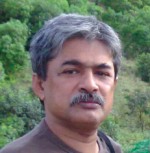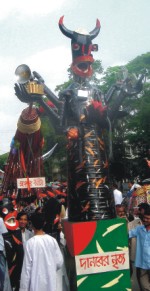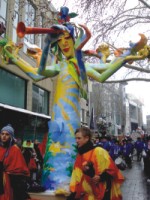| Home - Back Issues - The Team - Contact Us |
 |
| Volume 10 |Issue 10| March 11, 2011 | |
|
|
Art Of Masks and Ment Fayza Haq Saidul Haque Juisse – popular with both local and overseas patrons for his masks– spoke about his passion – sculpting. This he did at a Dhanmandi residence, over tea and biscuits, with his walrus moustache almost covering his pipe. He not only sculpts, but teaches, along with his wife, Fareha Zeba, a senior art teacher at a local school.
He traces the use of masks both in Bangladesh and abroad, as in India, Argentina and Africa. He then goes on to dwell on the importance of sculpture from ancient times till today. Haque is known for his papier-mâché masks, often seen at ‘Pahela Baishak’, apart from his cement and folded paper creations. His most recent art work was seen at Bengal Gallery. His creations, seen at the British Council and in front of the Parliament building (put there as a protest against religious bigots) in the recent past. Enormous, elongated, bright masks of a couple of Hindu deities welcome any visitor at his Banani residence. “Contemporary artists are making masks the world over,” says Juisse. “We, in Bangladesh, at one time went in for masks in a big way. It was there from time immemorial in Hindu culture. The plays dealing with deities seen in stage, and before, during, and after “puja”; during “jatra” functions. It was used mostly during religious functions. This was during the occasions of “pala” songs, “cho” dance (in West Bengal and also seen in Tangail in the forms of “shong” or monster that went from house to house). This manner of arousing the people is seen the world over, with the speech delivered behind the mask was meant to guide one to the righteous path. Masks flourished from ages back in Africa and even influenced artists as varied as Pablo Picasso and Hamiduzzaman. Bali, with its Hindu Indian cultural roots, sees masques aplenty as tourism flourishes there. The characters come with a religious origin. Here in Bangladesh, paper masks are sold by vendors, for fun, for children. These masks have an identity and a type.” “I thought to myself; why not begin my work based on these tiger and monster faces. I developed a style of my own. These are seen replete in our folk-art. From this base, I wanted to create something of my own. This has been successful right from the beginning at 'Pahela Baishak'. Hence I used masks to arouse the people, and give them pleasure as well. I'm reviving a well-loved element for a purpose. Masks are taken in a procession from the Dhaka University. This is called 'Mangal Shubha Jatra'."
He says that in recent times, masks are seen in carnivals as was seen in dances all over Europe and Latin America, for many centuries as in Shakespeare's ‘Romeo and Juliet’ and ‘A Midsummer's Night's Dream’. "Contemporary plays and dances use them too, in Bangladesh and worldwide. One also sees this in case of puppet theatre. However, the use of this in our country is not in large numbers, as I've witnessed overseas, giving importance to the mask,” says Haque. He says that it's a pity that using puppet in stage productions has not been considered as an institute. Once there was an institute of Performing Arts. The basic responsibility for this was to create ‘shilpis’. There was one in the “Shilpakala Academy”, says Haque. But this is not there now. There they have research programmes, discussions, exchange of views and news etc. Through the productions the country's culture sees expansion. Puppetry is important for Bangladesh, says Haque. Masks are a matter for reaching the masses. There should be an institute for this as there is for film development, he believes. By seeing quality films from overseas we've developed the urge and know how to create art films etc. The ‘Charukala Institute’ for eg is different from what is seen overseas. The art institutes deal with architecture. The natural connection of art with various people from different medias, as seen in India, for instance, is not there in our country, he says
Asked why he had focused on sculpture, when it is difficult to make it popular except in festivals, he says, “It's not difficult, one gets satisfaction and joy in doing something like this and reaching out to the people, transmitting a message in this process. There are certain elements done in our country, but these don't have a permanence.” Haque says that the sculptures one often sees have a particular national characteristic. They are not particularly artistic, modern or patriotic. The theme is often not clear. These pieces, says Haque, appear like ‘contract- based’ items and have no clear message for the mind, heart or soul. The number of artists has increased rapidly. What the art lovers are exposed to is enormous and the viewers are not satisfied by items which are clichéd. The height to which sculpture had risen in Bangladesh, says Haque, will not be seen in the near future. People can't have sculpture at home, as people now have no gardens, normally in the city, he adds. “Kept on tables, in large drawing rooms, sculpture has value, but it is not often seen in Dhaka. Yet new buildings are now in the hand of contractors, so to put it. What will overseas visitors find in Bangladesh? I feel that there's a large scope to delight people with perhaps not so permanent items which will last for shorter periods. Yet they will give people pleasure, and provide them with food for thought, says the confident and flamboyant sculptor. The media does not matter. What one does with it is important. I try to speak my mind with cheaper materials. One can do so much with any material, it depends on the artist. In the Export Fair I've designed a pavilion. The attraction of this is that it is 'Bangla' architecture and is made of local materials. It makes people realise that our own architecture can be so delightful. The image looks permanent, but is a temporary one.”
“It is made of mud and straw: However, it has a traditional design. We don't have to copy. We can work out something delightful of our own. We don't have to copy foreign catalogues. We can experiment and find new paths, which we weren't aware of before. This architecture is fifty feet by fifty feet. It's a massive structure. Here 'satranjis', originating from India during the Colonial times, made by a Rangpur group, are sold. The rugs were revived by an individual called Selim. Earlier, each pavilion was artistic. Now they're mere shopping outlets.” What Haque enjoys most is street art, as he had done before the Parliament building to protest the assassination of the finance minister, AMS Kibria. This was called ‘Danober Nrito’ This was revived during the ‘Pahela Baishak’ from the Shaheed Minar. The broom creation was one to protest against corruption and fundamentalists.
Tracing the importance of sculpture in Eastern and Western society– including Elora, Ajanta, Mainamati, Paharpur and Mohenjodaro – Haque says that the Mother Goddess was there in every society. Every important artist has dealt with the Mother and child theme. In Hindu culture we drown this sculpture piece, after having worshipped it. This deity was recreated in New Year, he says. The figurative and geometrical abstract shapes are parallel, believes Haque. The frescoes and wall-paintings, with ‘shora’ paintings go back to worship of deities. The needs of different societies were different. Men's needs differed with time and place. From the Renaissance on, and during the medieval times , most of the sculpture was to satisfy man's religious needs. Much before, ancient Egypt and China had overwhelming statues to feed men's religious needs, concludes Haque, winding up the tête-à-tête. Photos: courtesy
Copyright
(R) thedailystar.net 2010 |




